Contents
Juniper Rocky is similar to Virginian, they are often confused, there are many similar varieties. The species interbreed readily at the population boundary in the Missouri basin, forming natural hybrids. Rocky juniper grows in the mountains in the west of North America. Typically, the culture lives at an altitude of 500-2700 m above sea level, but along the shores of the Puget Sound bay complex and on Vancouver Island (British Columbia) it occurs at zero.
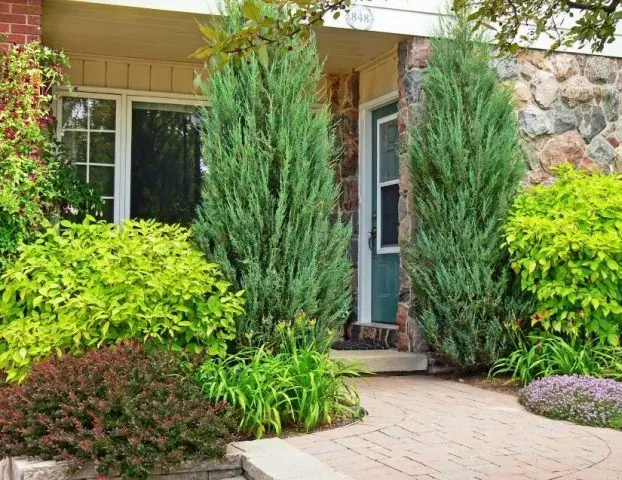
Description of rocky juniper
Rock Juniper (Juniperus Scopulorum) is a coniferous dioecious tree, often multi-stemmed, from the genus Juniper of the Cypress family. Cultivated since 1839, often under incorrect names. The first description of the rocky juniper was given in 1897 by Charles Sprague Sargent.
The crown at a young age is pyramidal, in older plants it becomes unevenly rounded. The shoots are clearly tetrahedral, thanks to which Rocky Juniper can be easily distinguished from Virgin Juniper. In addition, in the first species they are thicker.
The branches rise at a slight angle, begin to grow from the ground itself, the trunk is not exposed. The bark on young shoots is smooth, red-brown. With age, it begins to peel off and flake off.
The needles are most often grayish, but can be dark green; varieties with a gray-blue or silvery crown are especially valued in the culture. The needles on young specimens are hard and sharp, they can remain so at the beginning of the season at the top of the main shoot in adult plants. Then the needles become scaly, with a blunt tip, located oppositely, pressed against the shoot. However, she is quite tough.
The length of the prickly and scaly needles is different. Acute longer – up to 12 mm with a width of 2 mm, scaly – 1-3 and 0,5-1 mm, respectively.
The needles of an adult rocky juniper in the photo
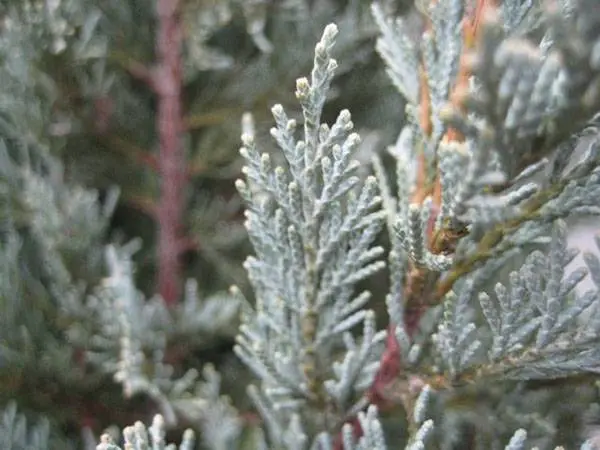
How fast does rocky juniper grow
Rocky juniper is classified as a species with an average growth force, its shoots increase by 15-30 cm per season. In culture, the pace is somewhat slowing down. By the age of 10, the height reaches an average of 2,2 m. An adult tree does not grow so fast, at the age of 30 it stretches by 4,5, sometimes 6 m. The diameter of the rocky juniper crown can reach 2 m.
Species plants in nature live a very long time. In the state of New Mexico, a dead tree was found, the cut of the trunk of which showed 1888 rings. Botanists believe that individual specimens in that area have reached an age of 2 thousand years or more.
All this time, rocky juniper continues to grow. Its maximum recorded height is considered to be 13 m, the crown can extend to 6 m. The diameter of the trunk until the age of 30 almost never exceeds 30 cm, in old specimens from 80 cm to 1 m, and according to some sources, 2 m.
The disadvantages of the species include low resistance to urban conditions and severe rust damage. This makes it impossible to plant rocky juniper near fruit trees.
When buying a culture, you should pay attention to the following fact. Not only junipers, but all North American conifers in Our Country grow much more slowly, due to different climates. In the USA and Canada, there are no such fluctuations in temperature as in the territory of the countries of the former Soviet Union, the soils and the annual rainfall are different.
Frost resistance rocky juniper
The species plant hibernates without shelter in zone 3. Rocky juniper is considered quite a suitable crop for the Moscow region, as it can withstand temperatures down to -40 ° C.
Flowering juniper rocky
This is a dioecious plant, that is, male and female flowers are formed on different specimens. The males are 2-4 mm in diameter and open and release pollen in May. Women form fleshy cones that ripen in about 18 months.
Unripe juniper fruits are green and may be tan. Ripe – dark blue, covered with a bluish wax coating, about 6 mm in diameter (up to 9 mm), rounded in shape. They contain 2 seeds, rarely 1 or 3.
Seeds germinate after prolonged stratification.

Varieties of rocky juniper
Interestingly, most varieties are based on populations growing in the Rocky Mountains, stretching from British Columbia in Canada to New Mexico (USA). Of particular interest are cultivars with bluish and steel-gray needles.
Rocky Juniper Blue Haven
The Blue Heaven variety was created before 1963 by the Plumfield Nursery (Fremont, Nebraska), its name translates as Blue Sky. In landscape design, Blue Haven juniper has gained immense popularity due to its bright blue needles that do not change color all year round. Its color is more intense than other varieties.
Forms a uniform squat pin-shaped crown. It grows rapidly, adding more than 20 cm annually. By the age of 10, it stretches to 2-2,5 m with a width of about 80 cm. The maximum size is 4-5 m, the crown diameter is 1,5 m.
It should be added to the characteristics of the juniper rocky Blue Haven that an adult tree bears fruit annually.
Frost resistance – zone 4. It tolerates urban conditions satisfactorily.
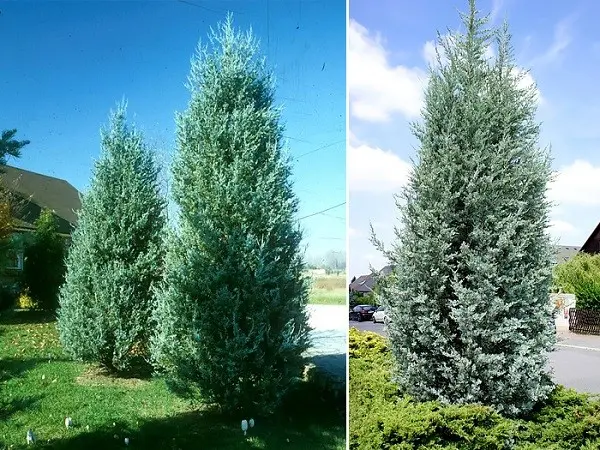
Rocky Juniper Moffat Blue
The Moffat Blue variety has a second name – Moffettii, which is more often used in special sources and on English-language sites. Differs in high decorative effect, satisfactory resistance to air pollution.
Some domestic nurseries are trying to present the variety as a novelty, but in America it has been grown for a long time. The cultivar appeared in 1937 thanks to the breeding work carried out by the Plumfield Nursery. The seedling from which the variety “began” was found in the Rocky Mountains by L. A. Moffett.
The crown of Moffat Blue is wide, pin-shaped, in an adult plant it gradually acquires a rounded shape. Branches dense, numerous. The variety belongs to growing at an average speed, adding 20-30 cm per season. By the age of 10, in conditions approximately reminiscent of natural ones, a tree can reach 2,5-3 m.
In Our Country, the size of the rocky juniper Moffat Blue is more modest – 1,5-2 m, with a crown width of 80 cm. And it will never give an increase of 30 cm, and 20 is unlikely. The mature Moffat Blue tree is presumably the same size as the species tree. But cultural observations have not been conducted long enough to assert this with complete certainty.
The cones of the rocky juniper Moffat Blue are dark blue with a bluish bloom, 4-6 mm in diameter.
The main charm of the variety is given by the color of the needles – green, with a silvery or blue tint. The young growth (which can reach 30 cm) is colored intensely.
Frost resistance – zone 4.
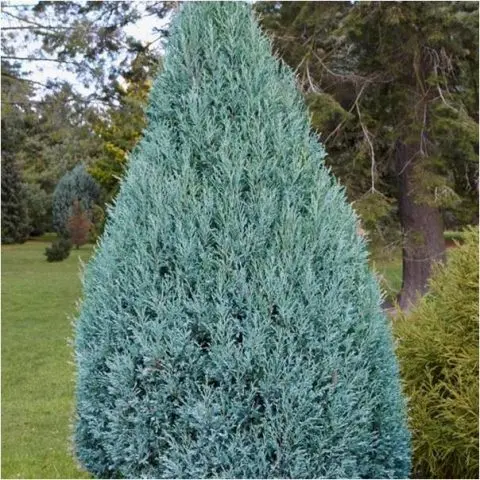
Rocky Juniper Wichita Blue
The variety was created in 1979. The rock juniper Wichita Blue is a male clone that reproduces only vegetatively. It forms a tree reaching a maximum height of 6,5 m with a diameter of not more than 2,7 m, with a wide-pin-shaped loose crown of thin tetrahedral shoots raised upwards. The bluish-green needles do not change color throughout the year.
Wintering without shelter – up to 4 zones inclusive.
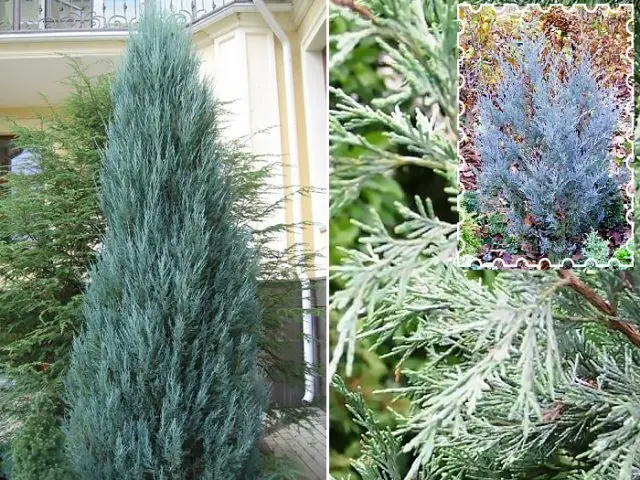
Rock Juniper Springbank
An interesting, rather rare variety Springbank was created in the second half of the 15th century. He adds 20-10 cm annually, which is considered a low growth rate. By the age of 2, it stretches up to 4 m, a mature plant reaches 80 m with a width of XNUMX cm.
The crown is cone-shaped, narrow, but due to the hanging tips of the shoots it seems much wider and somewhat untidy. The upper branches are separated from the trunk, the young shoots are very thin, almost filiform. Rock Juniper Sproingbank looks good in free style gardens, but is not suitable for formal gardens.
The needles are scaly, silver-blue. Requires a sunny position, as the color intensity decreases in partial shade. Frost resistance – the fourth zone. Propagated without loss of varietal characteristics by cuttings.
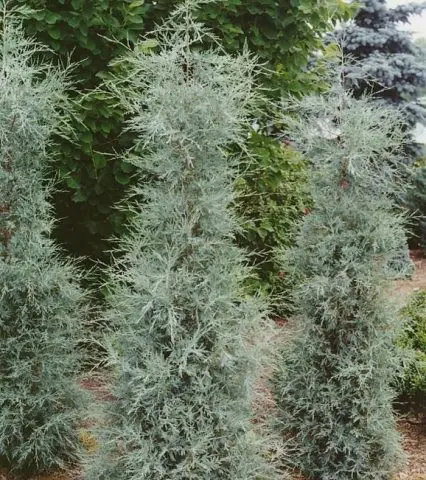
Rock Juniper Moonglow
The variety was created from a seedling selected in the 70s of the last century in the Hillside nursery, and is currently one of the most popular. Its name translates as Moonlight.
Juniperus scopulorum Moonglow forms a tree with a pyramidal crown. It belongs to fast-growing varieties, the annual growth is more than 30 cm. By the age of 10, it reaches a height of more than 3 m and a crown diameter of about 1 m, at 30 it stretches by 6 m with a width of 2,5 m.
The characteristics of rocky Moonglow juniper include silver-blue needles and beautiful outlines of a dense crown. A light shaping haircut may be required to maintain it.
Frost resistance – zones from 4 to 9.
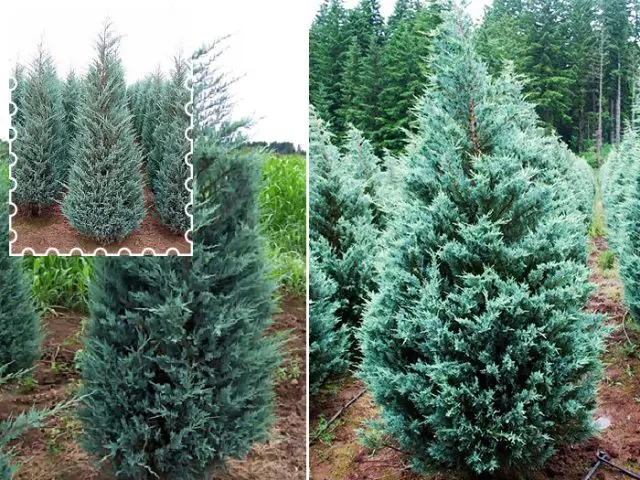
Juniper rock Skyrocket
The name of the rocky juniper variety is correctly spelled Sky Rocket, in contrast to the Virginian Skyrocket. But this is unimportant. The variety originated in 1949 in the nursery Shuel (Indiana, USA). He quickly became one of the most popular, which remains to this day, despite the strong rust damage.
Forms a crown in the form of a narrow cone, with a sharp top and tightly pressed branches. From this, the tree seems to be directed to the sky. In addition to an exceptionally beautiful crown, this rocky juniper with blue needles attracts attention. The needles are sharp at a young age, becoming scaly over time. But at the top of the tree and the ends of adult branches, the needles may remain prickly.
Skyrocket is a variety that reaches a height of 10 m by the age of 3 with a crown diameter of only 60 cm. Perhaps this does not make it the narrowest of all junipers, but among the rock ones, for sure.
At a young age, the tree holds its shape well and does not need pruning. Over time, especially with irregular care, that is, if years of careful care are replaced by seasons when the plant is “forgotten”, the crown may become less symmetrical. The situation is easily corrected by a haircut, which the culture tolerates perfectly.
Without shelter, wintering of rocky juniper Skyrocket in zone 4 is possible.
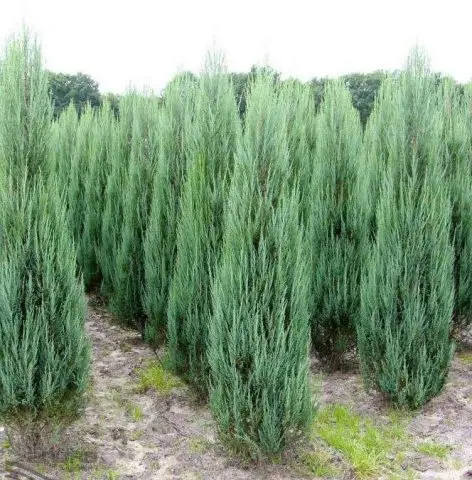
Rocky Juniper Blue Arrow
The variety name Blue Arrow translates as Blue Arrow. It originated in 1949 in the nursery Pin Grove (Pennsylvania). Some consider it an improved copy of the Skyrocket. Indeed, both varieties are mega-popular, similar to each other, and often the owners think for a long time which one to plant on the site.
At 10 years old, Blue Erru reaches a height of 2 m with a width of 60 cm. The crown is cone-shaped, the branches are directed upwards and are separated from the trunk at an acute angle.
The needles are stiff, needle-shaped on young plants, changing to scaly with age. If in the rocky juniper Skyrocket it has a bluish color, then the shade of Blue Arrow is rather blue.
Great for formal (regular) plantings. It hibernates without protection in zone 4. It keeps its shape at a mature age better than Skyrocket.

Juniper rocky in landscape design
Rocky junipers willingly use landscape designs when decorating the territory. They would recommend the crop for planting much more often, but it does not tolerate urban conditions well and is often affected by rust, which can destroy fruit tree crops.
Interesting! Many varieties of rock juniper have analogues among Juniperus virginiana cultivars, which are much more resistant to diseases, but they are not so beautiful.
Use in landscape design depends on the shape of the crown of the tree. Craggy juniper cultivars, such as Skyrocket or Blue Arrow, are planted in avenues and are often placed in formal gardens. In landscape groups, rockeries, rock gardens and flowerbeds, they can serve as a vertical accent. With proper garden planning, they are never used as a tapeworm.
But rocky junipers with a wide crown, for example, Moonglow and Wichita Blue will look good as single focal plants. They are planted more in romantic and natural gardens. You can form a hedge from them.
When planting, do not forget that the culture does not tolerate gas pollution. Therefore, even in the country, rocky juniper is recommended to be placed inside the territory, and not above the road.
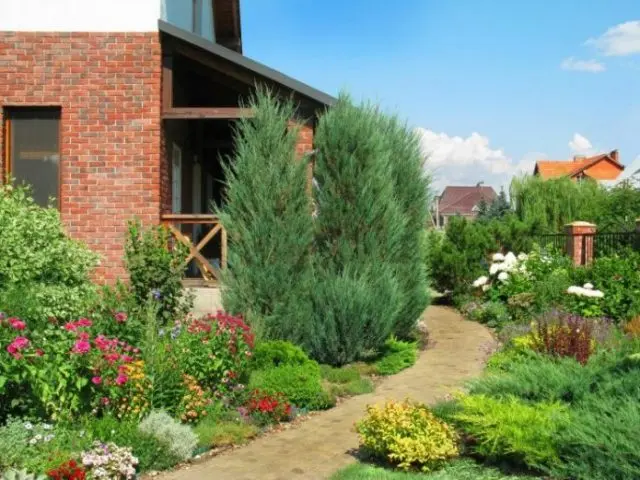
Planting and caring for rocky juniper
The culture is drought tolerant and quite healthy, this is clear from the description of rocky juniper, and it needs minimal care. The tree can be planted in rarely visited areas or where there is no way to provide abundant watering. The main thing is that the place is open to the sun, and the soil is not too fertile.
Rocky juniper should be planted in autumn in regions with a warm and temperate climate. It can last all winter if the hole is dug in advance. Planting rocky juniper in the spring makes sense only in the north, where the culture should have time to take root before the onset of real cold weather. Summers there are rarely hot enough to cause significant damage to a young plant.
Seedling and planting preparation
Rocky juniper will react positively to stony inclusions in the soil, but will not tolerate compaction, close standing groundwater or abundant irrigation. It must be placed on the terrace, make a thick drainage layer or build an embankment. In heavily blocking areas, it will be necessary to carry out measures to divert water or plant another crop.
A sunny place is suitable for a rocky juniper, in the shade the needles will become faded, its beauty will not be able to fully reveal itself. The tree must be protected from the wind for the first two years after planting. When a powerful root grows, it will not damage the juniper even during a squall.
The soil for planting a tree is made more loose and permeable with the help of soddy soil and sand; if necessary, it can be deoxidized with lime. Fertile soils will not benefit the rocky juniper, a large amount of sand is added to them, and if possible, small stones, gravel or screenings are mixed into the substrate.
The planting hole is dug deep enough to fit the root and drainage layer. The width should be 1,5-2 times the diameter of the earthen coma.
A minimum of 20 cm of drainage is poured into the hole for planting a rocky juniper, 2/3 is filled with earth, water is poured until it stops being absorbed. Let stand for at least 2 weeks.
It is better to buy seedlings from local nurseries. They must be grown in a container or dug out together with an earthen clod, the diameter of which is not less than the projection of the crown, and sheathed with burlap.
The substrate in a container or an earthen lump should be moist, the twigs should bend well, and the needles should emit a characteristic smell when rubbed. If planting is not done immediately after purchase, you will have to make sure that the root and needles do not dry out on your own.
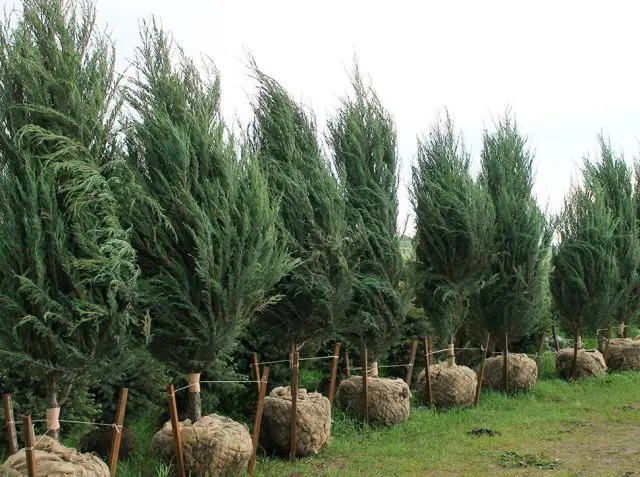
How to plant rocky juniper
Planting rocky juniper is not difficult. It is carried out in the following sequence:
- Part of the soil is removed from the landing pit.
- A seedling is placed in the center.
- The root collar should be flush with the edge of the hole.
- When planting juniper, the soil must be compacted so that voids do not form.
- The tree is watered, and the trunk circle is mulched.
Watering and top dressing
Rocky juniper needs frequent watering only for the first time after planting. When it takes root, the soil is moistened several times per season, and then with a long absence of rain, and in a dry autumn.
The rocky juniper reacts favorably to sprinkling of the crown, besides, it prevents the appearance of spider mites. In summer, the operation is carried out at least once a week, preferably in the early evening.
Root feeding of young plants is carried out twice a season:
- in the spring with a complex fertilizer with a high nitrogen content;
- at the end of summer, and in the south – in the fall with phosphorus and potassium.
Foliar top dressing, which is carried out no more than 1 time in 2 weeks, will be useful. It is recommended to add an ampoule of epin or zircon to the balloon.
Mulching and loosening
Seedlings are loosened in the year of planting to break the crust formed after watering or rain. It blocks access to the roots of moisture and air. Subsequently, the soil is mulched, preferably with pine bark treated for diseases and pests, which can be bought at garden centers. You can replace it with peat, rotted sawdust or wood chips. Fresh ones give off heat when rotting, and can damage or even destroy the plant.
How to prune rocky juniper
Rocky juniper pruning can be carried out all spring, and in regions with a cool and cold climate – until mid-June. First, remove all dry and broken shoots. Pay special attention to the middle of the bush.
In the rocky juniper, with its dense crown and branches pressed against each other, without access to light, part of the shoots dies off annually. If they are not removed, a spider mite, other pests will settle there, spores of fungal diseases will appear and multiply.
Cleaning the crown of the Rocky Juniper is not a vital procedure, as for the Canadian, but it cannot be called simply cosmetic. Without this operation, the tree will constantly hurt, and it is impossible to remove pests.
A shaping haircut is optional. In most varieties, the crown is already beautiful, but often some kind of twig will “break out of order” and stick out. This is what needs to be cut off so as not to spoil the view.
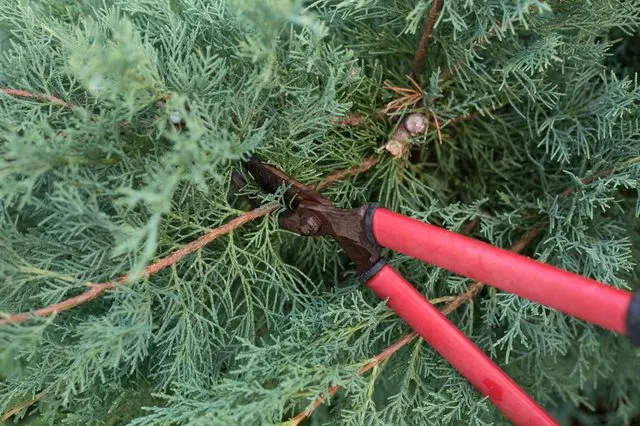
With age, in some pyramidal varieties, the crown begins to spread. It is also easy to tidy up with a haircut. Only you need to work not with a pruner, but with special garden shears or an electric brush cutter.
Bonsai are often created from rocky juniper in the USA. We usually use Virginian for this, but the cultures are so similar that they are rather traditions.
Preparing for the winter juniper rocky
In winter, rocky juniper should be covered only in the first year after planting and in frost resistance zones below the fourth. Its crown is wrapped with white spandbond or agrofiber, fixed with twine. The soil is mulched with a thick layer of peat.
But even in those warm regions where it can snow in winter, the rocky juniper crown needs to be tied. Do this carefully and not tight, so that the branches remain intact. If the crown is not fixed, the snow can simply break it.
How to propagate rocky juniper
Rock juniper is propagated by seeds or cuttings. Particularly rare and valuable varieties can be grafted, but this is a complex operation, and amateur gardeners cannot do it.
Propagation of rocky juniper by seeds does not always lead to success. Some seedlings do not inherit maternal traits, and they are rejected in nurseries. It is difficult for amateurs to figure out at an early stage of plant development whether it corresponds to a variety, especially since small junipers are completely different from adults.
In addition, long-term stratification is needed for seed propagation, and to carry it out correctly and not to spoil the planting material is not as easy as it might seem.
It is much easier, more reliable and faster to propagate rocky juniper by cuttings. You can take them all season. But for amateurs who do not have special premises, equipment and skills, it is better to carry out the operation in the spring.
The cuttings are taken with a “heel”, the lower part is freed from needles, treated with a stimulant, and planted in sand, perlite or a mixture of peat and sand. Keep in a cool place with high humidity. After 30-45 days, roots appear, and the plants are transplanted into a light soil mixture.
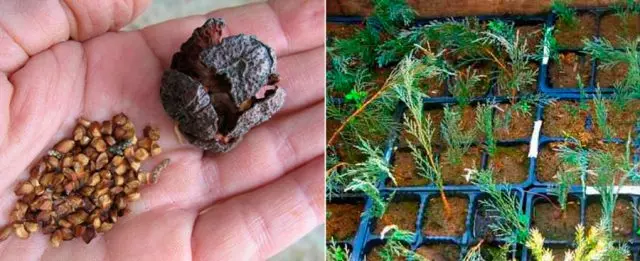
Pests and diseases of rocky juniper
In general, rock juniper is a healthy crop. But he can also have problems:
- Rock juniper is more susceptible to rust than other species. It harms the culture itself much less than fruit trees growing nearby.
- If the air is dry and the crown is not sprinkled, a spider mite will definitely appear. It is unlikely to destroy the tree, but it can greatly reduce the decorative effect.
- In a warm climate with frequent rains, and especially when sprinkling the crown late in the evening, when the needles do not have time to dry before night, a mealybug may appear. It is very difficult to get it out of the juniper.
- The lack of sanitary pruning and crown cleaning can turn the inside of the crown into a breeding ground for pests and diseases.
To prevent trouble, the tree must be regularly inspected and preventive treatments carried out. Insecticides and acaricides from pests, fungicides – to prevent diseases.
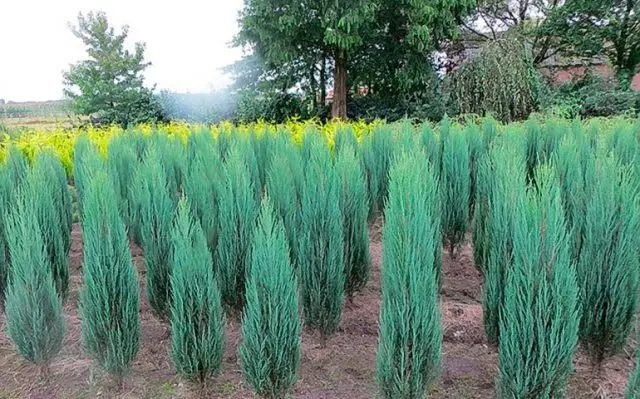
Conclusion
Rocky juniper is a beautiful, undemanding culture. Its main advantage is an attractively shaped crown, silver or blue needles, the disadvantage is low resistance to air pollution.









